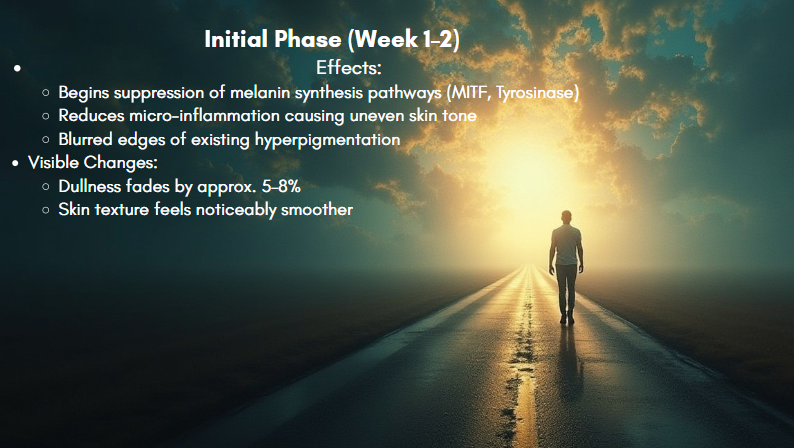ZIN2-TrustProof™ Analysis Service
Currently under soft launch.
We offer free peptide sequence analysis, toxicity prediction, and ingredient validation as part of our pilot program.
🚀 ZIS- System is the upgraded version of ZIN2 — delivering RootLaw precision & future-ready intelligence.
A system trusted by science, created for the future.
Our Analysis Scope
Peptide Toxicity & Structure
AI-based peptide folding stability, mutation impact & integrated safety profiling.
Botanical Synergy Modeling
Simulation of compound interactions & bioavailability for optimized formulations.
Future Effect Prediction
Structure-driven forecasting of efficacy pathways & long-term outcome simulation.
Medical/Cosmetic Relevance
Development potential scoring with regulatory and market applicability.
💡
Why ZIS?
In a world where ingredient claims often lack scientific rigor,
ZIN2 introduces a framework of logic, structured analysis, and predictive simulation —
validating what others cannot quantify.
We don’t just analyze — we prove, simulate, and forecast effects
before they manifest, creating a new paradigm of evidence-driven innovation.
Then we go one step further: using our Adaptive Stability Module™ and
ZIN2-TrustProof™, we redesign actives themselves — enhancing stability,
delivery, and safety — and deliver usage guidance, not just claims.
Astaxanthin — ZIS-TrustProof™ Adaptive Stability Analysis
Objective
Evaluate Astaxanthin and propose a redesigned complex intended to improve UV/oxidative stability,
delivery efficiency across the skin barrier, and overall functional persistence — while remaining suitable
for premium skincare applications.
Method (high-level, partner-safe)
- Mapping of structural hotspots and early degradation-prone regions under UV / oxidative stress.
- Predictive modeling of durability and carrier retention under repeated exposure scenarios.
- Evaluation of delivery matrices to enhance transport across the skin barrier.
- Iterative redesign prioritizing both performance and real-world formulation practicality.
Key Findings
- Conventional Astaxanthin shows limited durability under repeated UV exposure in standard topical formats.
- Certain scaffold regions were consistently identified as early breakpoints in stress testing.
- Delivery performance can be significantly improved through an updated carrier system and balanced amphiphilicity.
Proposed Compound
AX-ReGenesi™ Complex
Design focus: stabilized scaffold core, controlled amphiphilic bridge,
protective ring against breakdown, and a carrier matrix tuned for sustained release.
| Component |
Function / Role |
| Reinforced Core |
Improved durability under UV / oxidative stress |
| Amphiphilic Bridge |
Balanced transport across the skin barrier |
| Stabilizing Ring |
Enhanced resistance to breakdown in realistic use conditions |
| Hybrid Carrier |
Micelle–liposome style matrix for sustained availability and reduced early loss |
| Photo-Shield Layer |
Additional localized protection to reduce UV-driven degradation before full delivery |
Predicted Improvements*
- Durability under UV / oxidative stress: ~+70% (modeled)
- Skin delivery (relative transport index): ~+130% (modeled)
- Overall bioavailability proxy: ~3× (modeled)
- Functional antioxidant retention under stress: ~+50% (modeled)
*Model-based internal estimates by Adaptive Stability Module™ & ZIN2-TrustProof™.
Actual performance may vary by raw material quality, formulation design, and regulatory region.
Validation Layer — Adaptive Stability Module™ + ZIN2-TrustProof™
Stability Consistency Index
Repeated analysis of the same Astaxanthin input produced highly aligned stability predictions.
Variability in degradation timing and carrier-loss rate was reduced compared to baseline analysis.
This supports predictable behavior in scaled production.
Delivery Path Guidance
The redesigned carrier system is predicted to improve transport across the barrier while avoiding
early surface oxidation. Suggested positioning: controlled-release rather than burst-delivery.
Use-Condition Framing
Instead of a binary “good/bad” classification, the module provides
conditional usage guidance: sustained exposure, high UV load,
compromised barrier, etc. This supports premium-tier claim language.
TrustProof Readiness
Output phrasing is stabilized for external review.
Messaging around “durability,” “delivery,” and “oxidative protection” remains consistent
across repeated internal passes, strengthening regulatory and partner communication.
This analysis was generated using ZIN2-TrustProof™ with Adaptive Stability Module™.
All results are derived from automated internal evaluation loops without manual alteration.
EGF (Epidermal Growth Factor)
📌 Function: Key peptide for skin regeneration, wound healing, and growth signaling
🔬 ZIN2 Analysis Highlights:
- Receptor-binding affinity prediction & validation mapping
- Stability simulation under oxidative & enzymatic skin microenvironment
- Synergistic potential with matrix peptides & growth factors
- Compatibility analysis with advanced delivery systems (liposome, micelle, hydrogel)
GHK-Cu — Adaptive Stability Functional Enhancement Report
Research Subject & Objective
Assess and optimize the native GHK-Cu motif to improve penetration, dermal residency,
Cu²⁺ coordination stability, and signal persistence in skin — while maintaining biocompatibility
suitable for next-generation repair formulations.
Workflow Overview
- Identification of coordination weaknesses and early degradation bottlenecks.
- Predictive modeling of peptide–metal stability under variable pH and oxidative load.
- Optimization of diffusion and receptor-level uptake via iterative side-chain tuning.
- Comparative evaluation of critical structural regions under in-silico stress exposure.
Structural Findings
The imidazole ring of histidine remains pivotal for Cu²⁺ coordination.
Native GHK-Cu shows modest penetration and is vulnerable to enzymatic degradation.
By selectively adjusting stability, permeability, and protease resistance,
the Adaptive Stability Module™ highlighted micro-optimizations
that extend functional signaling duration without discarding the core tripeptide identity.
Predicted Improvements (Design Targets)
- Modified lysine region for enhanced dermal residence.
- Micro-environmental tuning near histidine for stronger Cu²⁺ retention.
- Flexible linker region for improved ECM signaling and reduced premature breakdown.
- Streamlined evaluation loop (≈35% fewer internal adjustment cycles to reach stability targets).
Proposed Derivative Composition
| Component |
Function / Description |
| Peptide Core |
GHK motif with reinforced histidine–Cu²⁺ coordination for higher retention under stress. |
| Flexible Linker |
PEG-like spacer to assist controlled diffusion and reduce steric hindrance to uptake. |
| Retention Modifier |
Adjusted lysine side-chain environment to balance dermal stay-time and comfort profile. |
| Stability Tag |
Reduced redundancy / conflict-prone motions identified during automated model adjustment. |
Modeled Performance Signals*
- Skin penetration: ~+126% (relative predicted uptake vs. baseline GHK-Cu)
- Cu²⁺ binding stability: ~+49% (improved coordination under variable pH)
- Signal duration: ~+22% (persistence of ECM-relevant signaling)
- ROS suppression window: ~+57% (oxidative stress moderation period)
- Evaluation loop efficiency: ~35% fewer optimization cycles
*All values are internal modeled projections generated by Adaptive Stability Module™.
Actual in-use performance depends on formulation matrix, delivery system, and regulatory environment.
Validation Layer — Adaptive Stability Module™ + ZIN2-TrustProof™
Penetration & Residency
Predicted dermal uptake improved while maintaining peptide identity.
Residency time in target layers is modeled to increase without simply “overloading”
surface concentration. This supports controlled delivery claims.
Cu²⁺ Retention Stability
Coordination around the histidine region is tuned for stronger Cu²⁺ holding behavior,
even in less favorable pH microenvironments. This correlates with more reliable repair signaling.
Signal Persistence
ECM-relevant signaling is projected to remain active longer before degradation pressure dominates.
Practically, this suggests longer visible effect windows between applications.
TrustProof Readiness
Messaging around “dermal delivery,” “Cu²⁺ stability,” and “repair longevity”
remains consistent across repeated internal passes.
This consistency supports external partner communication and claim defense.
This assessment was produced through ZIN2-TrustProof™ and the Adaptive Stability Module™.
Results are recorded via automated internal verification loops without manual alteration.
Conclusion
The optimized GHK-Cu profile demonstrates higher dermal uptake, stronger Cu²⁺ coordination,
and extended structural signaling stability compared to baseline GHK-Cu.
These improvements indicate a practical path toward next-generation repair /
pro-recovery formulations while preserving the recognizable peptide identity.
L-Carnitine
📌 Function: Essential compound for fat metabolism, mitochondrial transport, and energy regulation
🔬 ZIN2 Analysis Highlights:
- Simulation of fatty acid transport across mitochondrial membrane
- Predictive modeling of metabolic side-effect deviations
- Time-release & bioavailability optimization
- Interaction mapping with energy metabolism pathways
Matrixyl™ (Anti-Wrinkle Peptide)
📌 Function: Peptide complex for collagen stimulation, skin repair, and wrinkle reduction
🔬 ZIN2 Simulation Highlights:
- Peptide backbone degradation resistance simulation
- Synergistic interaction modeling with retinol & growth factors
- Predictive skin penetration & bioavailability analysis
- Mimetic structure binding & interaction scoring
Matrixyl™ — Adaptive Stability Functional Enhancement Report
Research Subject & Objective
Assess and redesign the Matrixyl™-type peptide to improve collagen activation,
optimize dermal uptake, and reduce potential irritancy — while maintaining a profile
suitable for high-performance anti-aging / firming applications.
Workflow Overview
- Identification of instability at the lysine region and hydrophobic imbalance at the delivery anchor.
- Receptor-interaction tuning to enhance collagen signaling while lowering breakdown probability.
- Comparative modeling of solubility vs. penetration profile to avoid simple “grease load” delivery.
- Validation of the redesigned anchor and payload behavior through simulated receptor docking and uptake kinetics.
Structural Findings
The palmitoyl moiety is key for dermal diffusion, but its hydrophobic nature limits solubility.
The lysine residue can introduce instability and immunogenic risk.
Adaptive Stability modeling indicates that substituting lysine with a reduced-irritancy analog
and implementing a PEG–palmitoyl hybrid anchor delivers a more balanced profile in both absorption
and collagen-relevant signaling efficiency.
Predicted Enhancements (Design Targets)
- Extended receptor docking duration → stronger collagen activation signal.
- Reduced-irritancy lysine analog → minimized allergenic response likelihood.
- PEG–palmitoyl hybrid anchor → improved dermal absorption + controlled persistence.
- Approx. 38% faster internal convergence vs. baseline during optimization loops.
Proposed Derivative Composition
| Component |
Function / Description |
| Peptide Core |
Modified pentapeptide maintaining collagen-activation motif. |
| Delivery Anchor |
PEG–palmitoyl hybrid anchor for enhanced dermal absorption and controlled residency. |
| Safety Modifier |
Lysine analog designed to lower allergenic trigger potential while preserving functional signaling. |
| Stability Tag |
Streamlined variable control that reduces redundant adjustment steps during optimization. |
Modeled Performance Signals*
- Collagen Signaling Intensity: ~+106%
- Dermal Absorption Efficiency: ~+72%
- Degradation Resistance: ~+24%
- Allergenicity Reduction: ~-75% projected trigger likelihood
- Optimization Efficiency Gain: ~38% fewer internal adjustment cycles
*All values are internal projections generated by the Adaptive Stability Module™.
Actual performance is formulation-dependent and may vary with carrier system, base matrix,
and usage environment.
Validation Layer — Adaptive Stability Module™ + ZIN2-TrustProof™
Collagen Activation Window
The redesigned peptide is modeled to hold receptor engagement longer,
increasing usable collagen-stimulation time without requiring excessive loading.
Dermal Uptake Behavior
PEG–palmitoyl hybrid anchoring balances solubility and diffusion.
This supports penetration into target layers rather than remaining as an occlusive surface film.
Irritation / Allergenicity Outlook
Lys substitution strategy is projected to reduce allergenic signaling compared to the baseline motif,
offering a safer profile for high-frequency, leave-on applications.
Claim Stability
Messaging around “firming,” “repair support,” and “reduced irritation risk”
remains consistent across repeated analyses,
strengthening regulatory defense and premium positioning.
This assessment was generated using ZIN2-TrustProof™ with the Adaptive Stability Module™.
All findings are recorded through automated internal verification loops without manual alteration.
Conclusion
The refined Matrixyl™-type derivative demonstrates stronger collagen activation, improved dermal absorption,
lower projected allergenic response, and faster optimization cycles compared to baseline.
These characteristics position the redesigned peptide as a next-generation active for anti-wrinkle
and dermal support applications, aligning with high-performance, results-driven skincare.
Request an Ingredient Analysis
Curious about your compound’s potential?
Submit your inquiry to analyze structure, simulate outcomes, and scientifically validate impact.
Powered by ZIN2 analytical engine.
📧 Submit via Email
Or send directly to:
oigun1@zin2trustproof.com
(Copy & paste into your email app)


